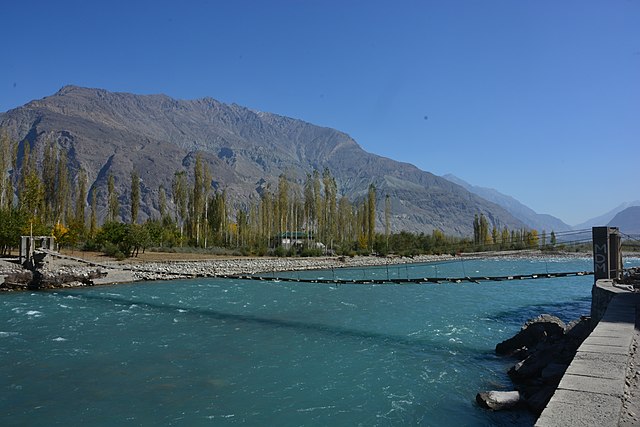Gilgit Valley
The Capital of Gilgit-Baltistan

Climate & Weather
Gilgit Valley has mild summers and cold winters, averaging around 15°C.

Speciality
Known for diverse landscapes, cultural heritage, and warm hospitality.

Transport Routes
Accessible via the Karakoram Highway and flights of Gilgit Airport.

Historical Places
Rich in history with ancient sites like Kargah Buddha and Gilgit Fort.

Tourist Points
3 spots: Naltar Valley, Fairy Meadow & Rakaposhi viewpoint.

Hotel/Restaurant
20 hotels and restaurants catering to various traveler preferences.

Facts & Figures'
A vital valley as a Capital of Gilgit-Baltistan, serving as a gateway to Hunza and Skardu.

Geographical Location
Located in northern Pakistan, the valley spans 38,000 km² at 1,500m altitude.
Popular Gilgit Valley Tourist Places:
Gilgit Valley, situated in the heart of Gilgit-Baltistan, Pakistan, is a place of breathtaking beauty, rich culture, and strategic significance. It serves as the gateway to some of the world’s 27th-highest peaks, including Rakaposhi, and is a hub for adventurers and nature lovers alike. The valley is known for its stunning landscapes, diverse culture, and historical importance, making it a must-visit destination for those exploring northern Pakistan.
Kargah Buddha

This ancient rock carving of Buddha, dating back to the 7th century, is located about 10 kilometers from Gilgit town. The site is a testament to the valley’s Buddhist past and offers a glimpse into its historical significance.
Gilgit Bridge
One of the longest suspension bridges in Asia, the Gilgit Bridge spans the Gilgit River and is a popular spot for tourists. The bridge offers stunning views of the river and surrounding mountains.


Bagrot Valley
A lesser-known but equally beautiful valley near Gilgit, Bagrot is known for its fruit orchards, glaciers, and traditional village life. It’s an ideal spot for those looking to explore off-the-beaten-path destinations.
Naltar Valley
Located about 34 kilometers from Gilgit, Naltar Valley is famous for its lush forests, beautiful lakes, and skiing slopes. It’s a perfect destination for nature lovers and adventure seekers.


Danyor Suspension Bridge Gilgit
The Danyor Suspension Bridge in Gilgit is a must-visit for thrill-seekers and nature lovers. This historic bridge connects Danyor to Gilgit, offering breathtaking views of the Karakoram Range and the roaring Gilgit River below. Crossing the bridge is an exhilarating experience, providing a unique way to immerse yourself in the stunning landscape and vibrant culture of the region.
Gilgit Valley offers a range of accommodation options to suit different budgets and preferences:
Hotels: Gilgit town has several hotels, ranging from luxury to budget-friendly. Some popular choices include the Serena Hotel, Gilgit, and the Riverdale Resort.
Guesthouses: For a more authentic experience, consider staying in a local guesthouse. These offer basic amenities with the added charm of local hospitality.
Camping: For those who love the outdoors, camping is a great option. There are several camping sites in and around Gilgit, offering beautiful views and a chance to connect with nature.
Gilgit Valley’s cuisine is a reflection of its cultural diversity, with influences from Central Asia, the Indian subcontinent, and the local Balti culture:
Traditional Dishes: Some of the must-try dishes include chapshuro (a meat-filled pastry), mamtu (steamed dumplings), and harissa (a meat and wheat dish). These dishes are hearty and full of flavor, perfect for the cold mountain climate.
Local Eateries: Gilgit town has several restaurants and eateries offering both local and Pakistani cuisine. Some popular spots include the Madina Restaurant and Karakoram Restaurant.
Gilgit Valley offers a variety of local handicrafts and souvenirs that reflect the region’s rich cultural heritage:
Pashmina Shawls: Gilgit is famous for its high-quality pashmina shawls, which are handwoven by local artisans. These shawls make for a beautiful and warm souvenir.
Wooden Carvings: Local craftsmen produce intricate wooden carvings, including boxes, trays, and decorative items. These make for unique gifts and mementos.
Gemstones: The region is rich in precious and semi-precious gemstones, including ruby, aquamarine, and topaz. These can be purchased from local markets and are often available at reasonable prices.
Here are some tips to ensure a safe and enjoyable visit to Gilgit Valley:
Best Time to Visit: The best time to visit Gilgit is from May to October when the weather is pleasant and all routes are accessible.
Local Customs: Gilgit is a conservative area, so it’s important to dress modestly and respect local customs, especially when visiting rural areas.
Safety Precautions: Gilgit Valley is generally safe, but it’s always a good idea to travel with a local guide, especially when venturing into remote areas.
Gilgit Valley offers countless opportunities for photography enthusiasts:
Gilgit Bridge: Capture the stunning views of the Gilgit River and surrounding mountains from the iconic suspension bridge.
Naltar Valley: The lush forests, colorful lakes, and snow-capped peaks of Naltar Valley provide a perfect backdrop for landscape photography.
Kargah Buddha: The ancient rock carving of Buddha, set against a mountainous backdrop, makes for a unique and historical photo opportunity.
How to Get To Gilgit Valley?
By Road
The Karakoram Highway (KKH), also known as the Eighth Wonder of the World, connects Gilgit to Islamabad and other major cities. The journey offers breathtaking views of the mountains and valleys, though it can be long and challenging due to the rugged terrain.
By Air
By Air: Gilgit Airport offers daily flights from Islamabad, with a flight time of about 1 hour. The flight provides a spectacular aerial view of the mountains, but it is highly weather-dependent, and flights can be delayed or canceled during bad weather.
A Traveller Guide to Gilgit Valley:
Trekking and Hiking:
The valley serves as a base for several trekking routes, including the trek to Rakaposhi Base Camp and the Karakoram Highway trek. These trails offer stunning views of the surrounding peaks and valleys.
Skiing:
Naltar Valley, near Gilgit, is one of the few places in Pakistan where you can enjoy skiing. The slopes are perfect for both beginners and experienced skiers.
Fishing:
The Gilgit River and its tributaries are rich in trout, making it a popular destination for fishing. The best time for fishing is from April to October.
Gilgit Valley experiences a varied climate due to its high altitude and mountainous terrain. Summers (May to September) are warm, with temperatures ranging from 15°C to 35°C, making it an ideal time for trekking and sightseeing. Winters (November to March) are cold, with temperatures often dropping below freezing, especially at night. The valley receives very little rainfall, making it an excellent destination for outdoor activities during the summer months.
Gilgit Valley is located in the Gilgit-Baltistan region of northern Pakistan. The valley sits at an altitude of about 1,500 meters above sea level and covers an area of approximately 38,000 square kilometers. It is surrounded by some of the world’s highest mountain ranges, including the Karakoram, Hindu Kush, and the Himalayas. The Gilgit River, a major tributary of the Indus River, flows through the valley, adding to its scenic beauty.
Gilgit Valley has a rich history dating back thousands of years. It was an important stop on the ancient Silk Road, connecting China to the West. The region has been influenced by various cultures, including Buddhist, Islamic, and British, each leaving its mark on the valley’s heritage. The valley is home to several historical sites, including ancient Buddhist rock carvings, forts, and stupas, reflecting its diverse cultural past.
To help you plan your trip, here are some suggested itineraries for Gilgit Valley:
3-Day Itinerary: Explore Gilgit town, visit Kargah Buddha and the Gilgit Bridge, and take a day trip to Naltar Valley.
5-Day Itinerary: In addition to the 3-day itinerary, include a visit to Bagrot Valley and a trek to Rakaposhi Base Camp.
